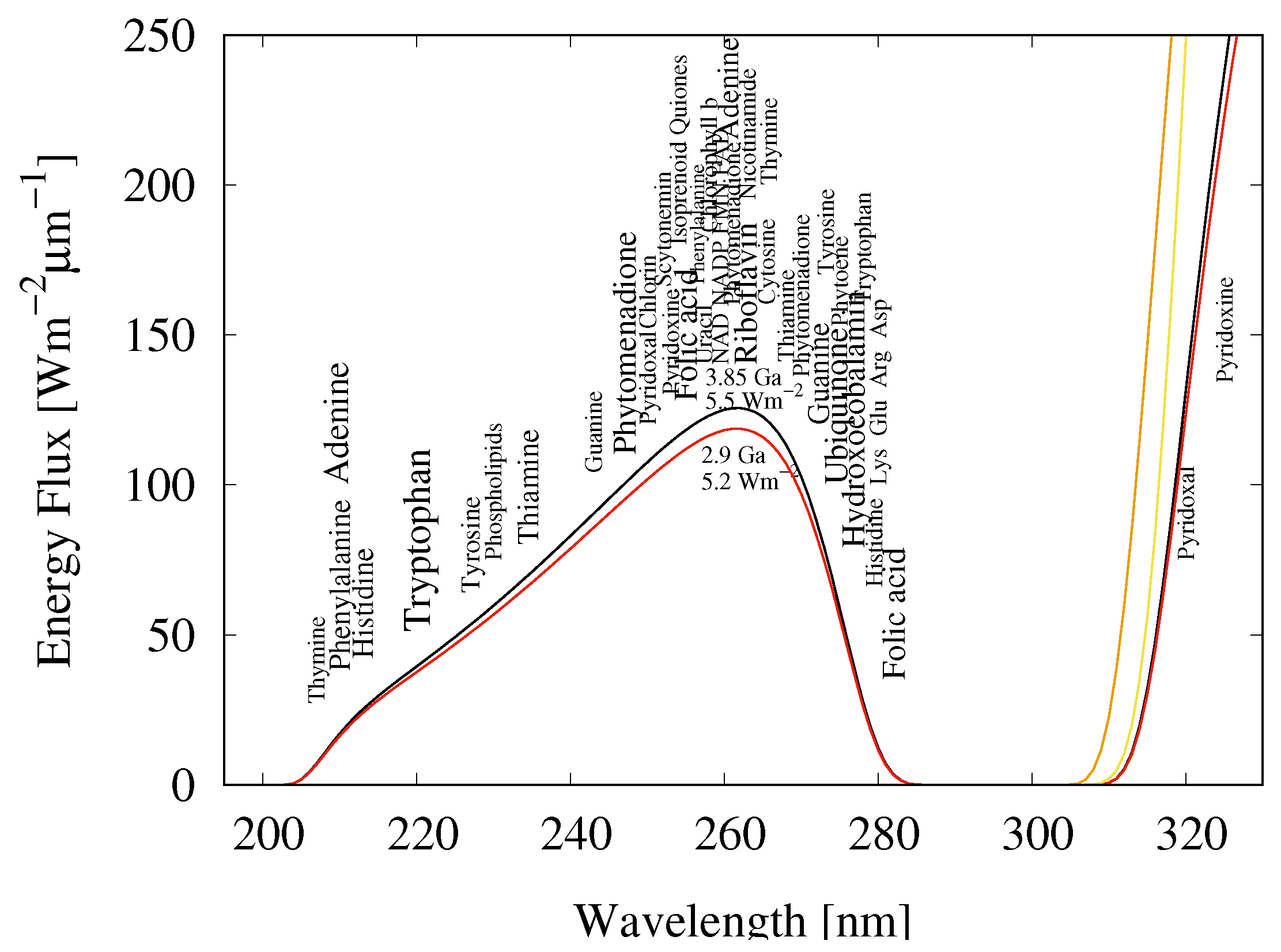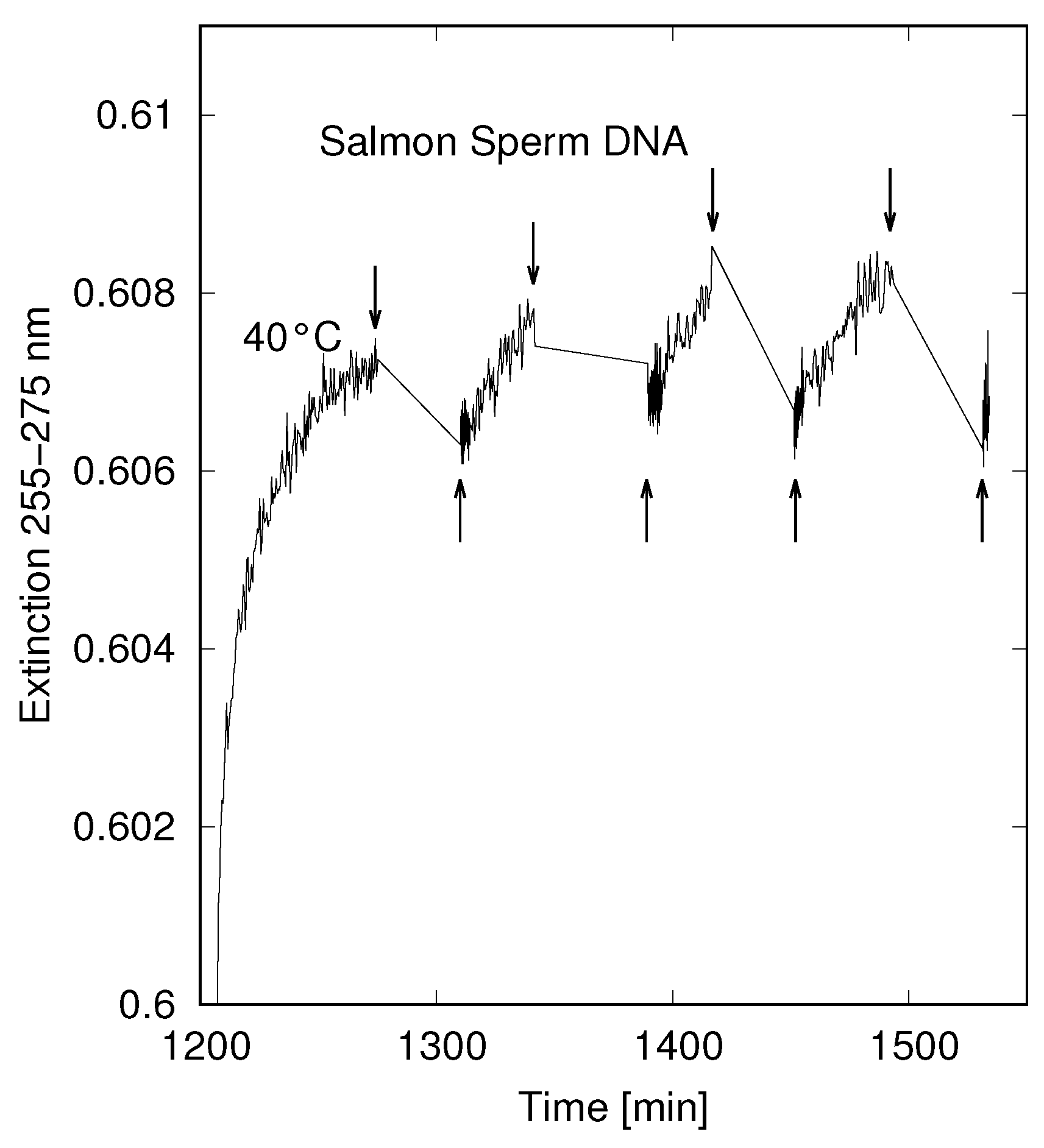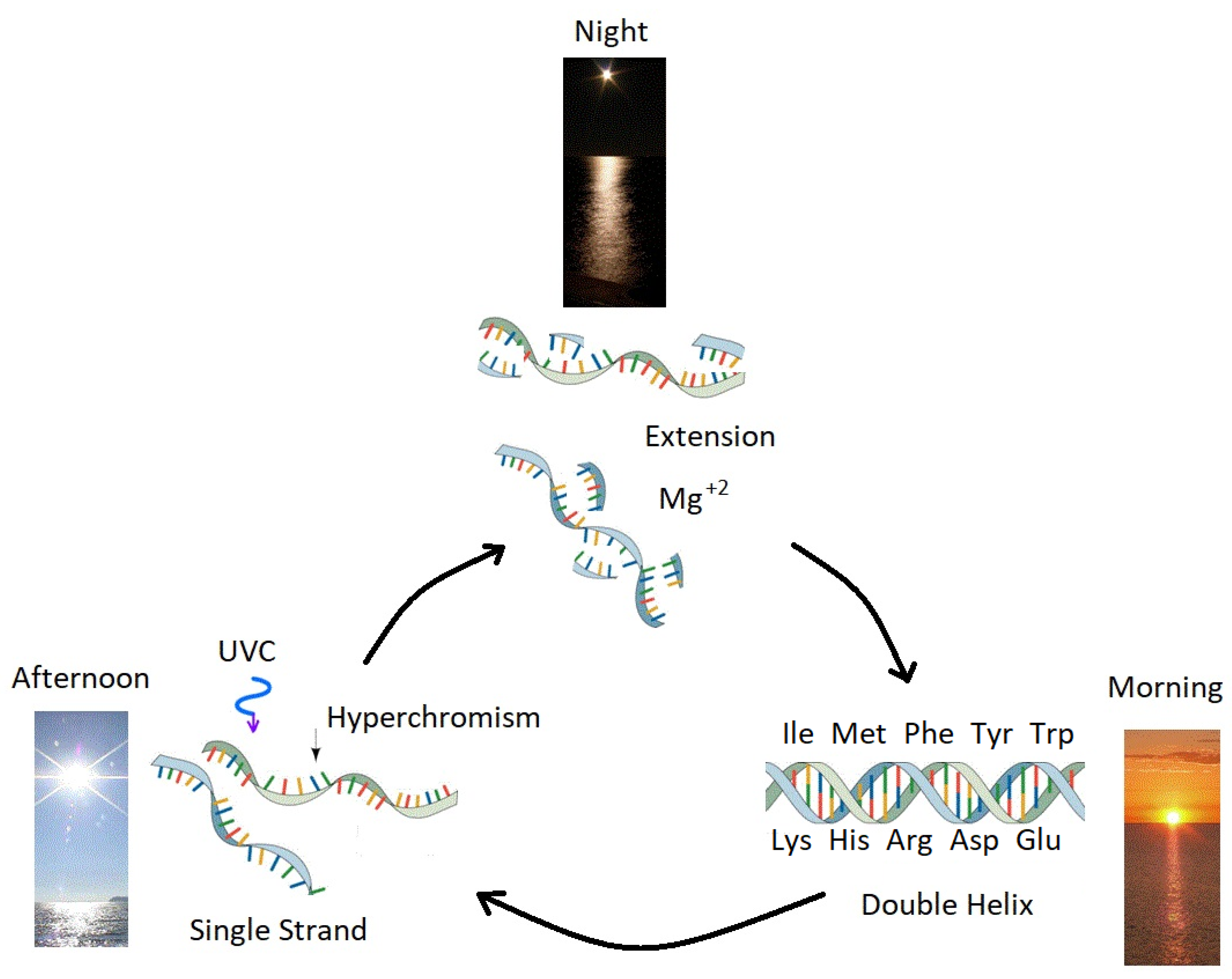Photon Dissipation as the Origin of Information Encoding in RNA and DNA
Abstract
1. Introduction
2. Foundations
3. Salient Properties of Amino Acid, Nucleic Acids, and Their Complexes
3.1. Absorption and Dissipation
3.2. Amino Acid Affinity to Codons (Or Anti-Codons) of DNA and RNA
4. Ultraviolet and Temperature Assisted Replication (Uvtar)
5. Accumulation of Information through the Dissipation-Replication Mechanism
5.1. Surface Entrapment: Amphipathic Molecules
5.2. Charge Neutralization
5.3. Antenna Molecules
5.4. Intercalation
5.5. Catalysis
6. Amino Acids Which Promote the Dissipation-Replication Relation Have Greatest Affinity to Their Codons/Anticodons
7. Discussion and Conclusions
“I am particularly struck by the difficulty of getting [the genetic code] started unless there is some basis in the specificity of interaction between nucleic acids and amino acids or polypeptides to build upon.”
Author Contributions
Funding
Conflicts of Interest
Abbreviations
| CIT | Clasical Irreversible Thermodynamics |
| DNA | Deoxyribonucleic Acid |
| DRT | Direct-RNA-Template theory for the code’s origin |
| EET | Excitation Energy Transfer |
| Ga | Giga (1000 million) years ago |
| NADH | reduced form of Nicotinamide Adenine Dinucleotide |
| NMR | Nuclear Magnetic Resonance |
| RNA | Ribonucleic Acid |
| RNPs | Ribonucleoprotein Particles |
| UV | Ultraviolet |
| UVB | Ultraviolet B 280–315 nm |
| UVC | Ultraviolet C 100–280 nm |
| UVTAR | enzymeless Ultraviolet and Temperature Assisted Replication mechanism |
References
- Woese, C.R. The Genetic Code: The Molecular Basis for Genetic Expression; Harper & Row: New York, NY, USA, 1967. [Google Scholar]
- Yarus, M. Amino Acids as RNA Ligands: A Direct-RNA-Template Theory for the Codes Origin. J. Mol. Evol. 1998, 47, 109–117. [Google Scholar] [CrossRef] [PubMed]
- Yarus, M.; Caporaso, J.G.; Knight, R. Origins The Genetic Code: The Escaped Triplet Theory. Annu. Rev. Biochem. 2005, 74, 179–198. [Google Scholar] [CrossRef] [PubMed]
- Crick, F. The origin of the genetic code. J. Mol. Biol. 1968, 38, 367–379. [Google Scholar] [CrossRef]
- Koonin, E.V. Frozen Accident Pushing 50: Stereochemistry, Expansion, and Chance in the Evolution of the Genetic Code. Life 2017, 7, 22. [Google Scholar] [CrossRef]
- Wong, J.T.F. Co-Evolution Theory of Genetic Code. Proc. Natl. Acad. Sci. USA 1975, 72, 1909–1912. [Google Scholar] [CrossRef]
- Michaelian, K. Thermodynamic origin of life. arXiv 2009, arXiv:0907.0042. [Google Scholar] [CrossRef]
- Michaelian, K. Thermodynamic dissipation theory for the origin of life. Earth Syst. Dynam. 2011, 224, 37–51. [Google Scholar] [CrossRef]
- Michaelian, K. Microscopic Dissipative Structuring and Proliferation at the Origin of Life. Heliyon 2017, 3, e00424. [Google Scholar] [CrossRef]
- Michaelian, K. Photochemical Dissipative Structuring, Proliferation and Evolution at the Origin of Life. arXiv 2020, arXiv:2007.00618. [Google Scholar]
- Onsager, L. Reciprocal Relations in Irreversible Processes, I. Phys. Rev. 1931, 37, 405–426. [Google Scholar] [CrossRef]
- Onsager, L. Reciprocal Relations in Irreversible Processes, II. Phys. Rev. 1931, 38, 2265. [Google Scholar] [CrossRef]
- Prigogine, I.; Nicolis, G. Biological order, structure and instabilities. Q. Rev. Biophys. 1971, 4, 107–144. [Google Scholar] [CrossRef] [PubMed]
- Glansdorff, P.; Prigogine, I. Thermodynamic Theory of Structure, Stability and Fluctuations; Wiley-Interscience: Hoboken, NJ, USA, 1971. [Google Scholar]
- Gaspard, P. Engineering of Chemical Complexity; chapter Self-Organization at the Nanoscale Scale in Far-From-Equilibrium Surface Reactions and Copolymerizations; World Scientific: Singapore, 2013; pp. 51–77. [Google Scholar]
- Gaspard, P. Fluctuation theorem for nonequilibrium reactions. J. Chem. Phys. 2004, 120, 8898–8905. [Google Scholar] [CrossRef] [PubMed]
- Andrieux, D.; Gaspard, P. Fluctuation Theorem for Currents and Schnakenberg Network Theory. J. Stat. Phys. 2007, 127, 107–131. [Google Scholar] [CrossRef]
- Onsager, L.; Machlup, S. Fluctuations and Irreversible Processes. Phys. Rev. 1953, 91, 1505–1512. [Google Scholar] [CrossRef]
- Prigogine, I. Introduction to Thermodynamics Of Irreversible Processes, 1st ed.; John Wiley & Sons: Hoboken, NJ, USA, 1955. [Google Scholar]
- Ferris, J.P.; Chen, C.T. Chemical evolution. XXVI. Photochemistry of methane, nitrogen, and water mixtures as a model for the atmosphere of the primitive earth. J. Am. Chem. Soc. 1975, 97, 2962–2967. [Google Scholar] [CrossRef]
- Michaelian, K. Thermodynamic Dissipation Theory of the Origina and Evolution of Life: Salient characteristics of RNA and DNA and Other Fundamental Molecules Suggest an Origin of Life Driven by UV-C Light; Self-published; CreateSpace: Mexico City, Mexico, 2016; ISBN 9781541317482. [Google Scholar]
- Kleidon, A.; Lorenz, R.D. Non-Equilibrium Thermodynamics and the Production of Entropy: Life, EARTH, and Beyond; chapter Entropy Production by Earth System Processes; Springer: Berlin/Heidelberg, Germany, 2005; pp. 1–20. ISBN 3-540-22495-5. [Google Scholar]
- Kleidon, A. Maximum entropy production and general trends in biospheric evolution. Paleontol. J. 2009, 43, 980–985. [Google Scholar] [CrossRef]
- Sagan, C. Ultraviolet Selection Pressure on the Earliest Organisms. J. Theor. Biol. 1973, 39, 195–200. [Google Scholar] [CrossRef]
- Kasting, J. Earth’s Early Atmosphere. Science 1993, 259, 920–926. [Google Scholar] [CrossRef]
- Michaelian, K.; Simeonov, A. Fundamental molecules of life are pigments which arose and co-evolved as a response to the thermodynamic imperative of dissipating the prevailing solar spectrum. Biogeosciences 2015, 12, 4913–4937. [Google Scholar] [CrossRef]
- Michaelian, K. A non-linear irreversible thermodynamic perspective on organic pigment proliferation and biological evolution. J. Phys. Conf. Ser. 2013, 475, 012010. [Google Scholar] [CrossRef]
- Prigogine, I. Introduction to Thermodynamics Of Irreversible Processes, 3rd ed.; John Wiley & Sons: Hoboken, NJ, USA, 1967. [Google Scholar]
- Michaelian, K. The biosphere: A thermodynamic imperative. In The Biosphere; IntechOpen: London, UK, 2012. [Google Scholar]
- Middleton, C.T.; de la Harpe, K.; Su, C.; Law, Y.K.; Crespo-Hernández, C.E.; Kohler, B. DNA Excited—State dyanmics: from single bases to the double helix. Annu. Rev. Phys. Chem. 2009, 60, 217–239. [Google Scholar] [CrossRef]
- Ferris, J.P.; Orgel, L.E. An Unusual Photochemical Rearrangement in the Synthesis of Adenine from Hydrogen Cyanide. J. Am. Chem. Soc. 1966, 88, 1074. [Google Scholar] [CrossRef]
- Michaelian, K.; Simeonov, A. Thermodynamic explanation of the cosmic ubiquity of organic pigments. Astrobiol. Outreach 2017, 5, 156. [Google Scholar] [CrossRef]
- Crick, F.H.C. The Genetic Code—Yesterday, Today, and Tomorrow. In Cold Spring Harbor Symposia on Quantitative Biology; Cold Spring Harbor Laboratory Press: Cold Spring Harbor, NY, USA, 1966; Volume 31, pp. 1–9. [Google Scholar]
- Woese, C.R.; Dugre, D.H.; Saxinger, W.C.; Dugre, S.A. On the fundamental nature and evolution of the genetic code. In Cold Spring Harbor Symposia on Quantitative Biology; Cold Spring Harbor Laboratory Press: Cold Spring Harbor, NY, USA, 1966; Volume 31, pp. 723–736. [Google Scholar]
- Toulmé, J.; Charlier, M.; Heléme, C. Specific Recognition of Single-Stranded Regions in Ultraviolet Irradiated and Heat-Denatured DNA by Tryptophan-Containing Peptides. Proc. Natl. Acad. Sci. USA 1974, 71, 3185–3188. [Google Scholar] [CrossRef]
- Orgel, L.E. A possible Step in the Origin of the Genetic Code. In Cosmochemical Evolution & the Origins of Life Volume II.; D Reidel Publishing Company: Boston, MA, USA, 1974; p. 313. [Google Scholar]
- Lacey, J.C.J.; Weber, A.L. Protein Structure and Evolution; Marcel-Dekker: New York, NY, USA, 1976; p. 213. [Google Scholar]
- Weber, A.L.; Lacey, J.C. Genetic Code Corelations: Amino Acids and Their Anticodon Nucleotides. J. Mol. Evol. 1978, 11, 199–210. [Google Scholar] [CrossRef]
- Hendry, L.B.; Witham, F.H. Gene regulation: The involvement of stereochemical recognition in DNA-small molecule interactions. Perspect. Biol. Med. 1979, 21, 120–130. [Google Scholar] [CrossRef]
- Hendry, L.B.; Bransome, E.D.; Hutson, M.S.; Campbell, L.K. First approximation of a stereochemical rationale for the genetic code based on the topography and physicochemical properties of “cavities” constructed from models of DNA. Proc. Natl. Acad. Sci. USA 1981, 78, 7440–7444. [Google Scholar] [CrossRef]
- Alberti, S. The Origin of Genetic Code and Protein Synthesis. J. Mol. Evol. 1997, 45, 352–358. [Google Scholar] [CrossRef]
- Knight, R.D.; Landweber, L.F. Rhyme or reason: RNA-arginine interations and the genetic code. Chem. Biol. 1998, 5, R215–R220. [Google Scholar] [CrossRef]
- Majerfeld, I.; Puthenvedu, D.; Yarus, M. RNA Affinity for Molecular L-Histidine; Genetic Code Origins. J. Mol. Evol. 2005, 61, 226–235. [Google Scholar] [CrossRef] [PubMed]
- Serganov, A.; Huang, L.; Patel, D.J. Structural insights into amino acid binding and gene control by a lysine riboswitch. Nature 2008, 455, 1263–1267. [Google Scholar] [CrossRef]
- Yarus, M.; Widmann, J.; Knight, R. RNA-Amino Acid Binding: A Stereochemecal Era for the Genetic Code. J. Mol. Evol. 2009, 69, 406–429. [Google Scholar] [CrossRef] [PubMed]
- Johnson, D.; Wang, L. Imprints of the genetic code in the ribosome. Proc. Natl. Acad. Sci. USA 2010, 107, 8298–8303. [Google Scholar] [CrossRef] [PubMed]
- Dougherty, D.A. Cation-p Interactions Involving Aromatic Amino Acids. J. Nutr. 2007, 137, 1504S–1508S. [Google Scholar] [CrossRef] [PubMed]
- Kamiichi, K.; Danshita, M.; Minamino, N.; Doi, M.; Ishida, T.; Inoue, M. Indole Ring Binds to 7-methylguanine Base by π-π Stacking Interaction. FEBS Lett. 1986, 195, 57–60. [Google Scholar] [CrossRef]
- AD, G.; Heroux, A.; RP, R.; RT, B. Crystal structure of the lysine riboswitch regulatory mRNA element. J. Biol. Chem. 2008, 283, 22347–22351. [Google Scholar]
- Govi, G.; Kumar, N.Y.; Kumar, M.R.; Hosur, R.V.; Roy, K.B.; Miles, H.T. Recognition Schemes for Protein-Nucleic Acid Interactions. J. Biosci. 1985, 8, 645–656. [Google Scholar] [CrossRef]
- Hendry, L.B.; Bransome, E.D. Are there Structural Analogies Between Amino Acids and Nucleic Acids? Orig. Life 1981, 11, 203–221. [Google Scholar] [CrossRef]
- Copley, S.D.; Smith, E.; Morowitz, H.J. A mechanism for the association of amino acids with their codons and the origin of the genetic code. Proc. Natl. Acad. Sci. USA 2005, 102, 4442–4447. [Google Scholar] [CrossRef]
- Fox, S.; Lacey, J.J.; Nakashima, T. Nucleic Acid-Protein Interactions; Ribbon, D.W., Woessner, J.F., Eds.; North-Holland Pub. Co.: Amsterdam, The Netherlands, 1971; p. 113. [Google Scholar]
- Takagi, Y.; Ikeda, Y.; Taira, K. New Aspects in Phosphorus Chemistry IV; Chapter Ribozyme Mechanisms; Springer: Berlin/Heidelberg, Germany, 2004; pp. 213–266. [Google Scholar]
- Lipfert, J.; Norman, J.O.D.G.; Doniach, S.; Lilley, D.M. The complete VS ribozyme in solution studied by small-angle Xray scattering. Structure 2008, 16, 1357–1367. [Google Scholar] [CrossRef] [PubMed]
- Nakano, S.i.; Chadalavada, D.M.; Bevilacqua, P.C. General Acid-Base Catalysis in the Mechanism of a Hepatitis Delta Virus Ribozyme. Science 2000, 287, 1493–1497. [Google Scholar] [CrossRef] [PubMed]
- Lowe, D.R.; Tice, M.M. Geologic evidence for Archean atmospheric and climatic evolution: Fluctuating levels of CO2, CH4, and O2 with an overriding tectonic control. Geology 2004, 32, 493–496. [Google Scholar] [CrossRef]
- Michaelian, K.; Santillán, N. DNA Denaturing through UV-C Photon Dissipation: A Possible Route to Archean Non-enzymatic Replication. bioRxiv 2014, 009126. [Google Scholar] [CrossRef]
- Michaelian, K.; Santillán, N. UVC photon-induced denaturing of DNA: A possible dissipative route to Archean enzyme-less replication. Heliyon 2019, 5, e01902. [Google Scholar] [CrossRef]
- Szostak, J.W. The eightfold path to non-enzymatic RNA replication. J. Syst. Chem. 2012, 3, 2. [Google Scholar] [CrossRef]
- Dubey, R.K.; Tripathi, D.N. A study of thermal denaturataion/renaturation in DNA using laser light scattering: A new approach. Indian J. Biochem. Biophys. 2005, 42, 301–307. [Google Scholar]
- Vekshin, N. Photonics of Biopolymers, 1st ed.; KomKniga: Moscow, Russia, 2005. [Google Scholar]
- Horowitz, E.D.; Engelhart, A.E.; Chen, M.C.; Quarles, K.A.; Smit, h.M.W.; Lynn, D.G.; Hud, N.V. Intercalation as a means to suppress cyclization and promote polymerization of base-pairing oligonucleotides in a prebiotic world. Proc. Natl. Acad. Sci. USA 2010, 107, 5288–5293. [Google Scholar] [CrossRef]
- Eickbush, T.H.; Moudrianakis, E.N. A Mechanism for the Entrapment of DNA at Air-Water Interface. Biophys. J. 1977, 18, 275–288. [Google Scholar] [CrossRef]
- Trifonov, E.N. Evolution of the Code and the Earliest Proteins: Reconstruction from Present-Day Sequences. Biophysics 2002, 47, 539–544. [Google Scholar]
- Prasad, S.; Mandal, I.; Singh, S.; Paul, A.; Mandal, B.; Venkatramani, R.; Swaminathan, R. Near UV-Visible electronic absorption originating from charged amino acids in a monomeric protein. Chem. Sci. 2017, 8, 5416–5433. [Google Scholar] [CrossRef] [PubMed]
- Knauth, L.P. Temperature and salinity history of the Precambrian ocean: Implications for the course of microbial evolution. Paleogeographys. Paleoclimatol. Paleoecol. 2005, 219, 53–69. [Google Scholar] [CrossRef]
- Lovelock, J.E. The Ages of Gaia; A Biography of Our Living Earth; W. W. Norton & Company: New York, NY, USA, 1988. [Google Scholar]
- Bensasson, R.V.; Land, E.J.; Truscott, T.G. Flash Photolysis and Pulse Radiolysis: Contributions to the Chemistry of Biology and Medicine; Pergamon Press: Oxford, UK, 1983. [Google Scholar]
- Cadet, J.; Vigni, P. Bioorganic Photochemistry: Photochemistry and the Nucleic Acids; John Wiley & Sons: Hoboken, NJ, USA, 1990; pp. 1–273. [Google Scholar]
- Montenay-Garestier, T.; Helene, C. Molecular Interactions between Tryptophan and Nucleic Acid Components in Frozen Aqueous Solutions. Nature 1968, 217, 844–845. [Google Scholar] [CrossRef] [PubMed]
- Montenay-Garestier, T.; Helene, C. Reflectance and luminescence studies of molecular complex formation between tryptophan and nucleic acid components in frozen aqueous solutions. Biochemistry 1971, 10, 300–309. [Google Scholar] [PubMed]
- Montenay-Garestier, T.; Toulmi, F.; Fidy, J.; Toulmi, J.J.; Le Doan, T.; Helene, C. Structure, Dynamics, Interactions and Evolution of Biological Macromolecules; Reidel: Kufstein, Austria, 1982; pp. 113–128. [Google Scholar]
- Rajeswari, M.R.; Montenay-Garestier, T.; Helene, C. Does tryptophan intercalate in DNA? A comparative study of peptide binding to alternating and non-alternating A.cntdot.T sequences. Biochemistry 1987, 26, 6825–6831. [Google Scholar] [CrossRef] [PubMed]
- Kleinwächter, V.; Koudelka, J. Thermal denaturation of deoxyribonucleic acid-acridine orange complexes. Biochim. Biophys. Acta-(Bba)-Spec. Sect. Nucleic Acids Relat. Subj. 1964, 91, 539–540. [Google Scholar] [CrossRef]
- Gudgin, E.; Lopez-Delgado, R.; Ware, W.R. The tryptophan fluorescence lifetime puzzle. A study of decay times in aqueous solution as a function of pH and buffer composition. Can. J. Chem. 1971, 59, 1037–1045. [Google Scholar] [CrossRef]
- Mondal, M.; Mukherjee, S.; Bhattacharyya, D. Contribution of phenylalanine side chain intercalation to the TATA-box binding protein–DNA interaction: Molecular dynamics and dispersion-corrected density functional theory studies. J. Mol. Model. 2014, 20, 2499. [Google Scholar] [CrossRef]
- Saidel, L.J.; Goldfarb, A.; Waldman, S. The absorption spectra of amino acids in the region two hundred to two hundred and thirty millimicrons. J. Biol. Chem. 1952, 197, 285–291. [Google Scholar]
- Cataldo, F. A study on ethylene and acetylene photoligomerization and photopolymerization. Photochem. Photobiol. 1996, 99, 75–81. [Google Scholar] [CrossRef]
- Michaelian, K.; Rodriguez, O. Prebiotic fatty acid vesicles through photochemical dissipative structuring. Rev. Cuba QuíMica 2019, 31, 354–370. [Google Scholar]
- Botta, O.; Martins, Z.; Emmenegger, C.; Dworkin, J.P.; Glavin, D.P.; Harvey, R.P.; Zenobi, R.; Bada, J.L.; Ehrenfreund, P. Polycyclic aromatic hydrocarbons and amino acids in meteorites and ice samples from LaPaz Icefield, Antarctica. Meteorit. Planet. Sci. 2008, 43, 1465–1480. [Google Scholar] [CrossRef]
- Allamandola, L.; Tielens, A.; Barker, J. Polycyclic aromatic hydrocarbons and the unidentified infrared emission bands: Auto exhaust along the Milky Wayexclamation. Astrophys. J. 1985, 290, L25–L28. [Google Scholar] [CrossRef]
- Rossmann, M.G.; Moras, D.; Olsen, K.W. Chemical and biological evolution of a nucleotide-biding protein. Nature 1974, 250, 194–199. [Google Scholar] [CrossRef] [PubMed]
- Dayhoff, M.; Schwartz, R.; Orcutt, B. A Model of Evolutionary Change in Proteins. Atlas Protein Seq. Struct. 1978, 5, 345–351. [Google Scholar]



| Amino Acid | Abbreviation | Codon | Codon/Anticodon Specificity | Amphipathic | Antenna 260 nm | Intercalating | Catalysis | Charge Neutralizing |
|---|---|---|---|---|---|---|---|---|
| Aliphatic non-polar R group (Hydrophobic) | ||||||||
| Glycine | Gly | GGU GGC GGA GGG | +/ | |||||
| Alanine | Ala | GCU GCC GCA GGG | ||||||
| Proline | Pro | CCU CCC CCA GGG | ||||||
| Valine | Val | GUU GUC GUA GUG | ||||||
| Leucine | Leu | UUA UUG CUU CUC CUA CUG | +/+ /vw | |||||
| Isoleucine | Ile | AUU | s/ | |||||
| AUC | +/+ | yes | ||||||
| AUA | /s | |||||||
| methionine | Met | AUG | /+ | yes | yes | |||
| Aromatic R group (Slightly hydrophobic) | ||||||||
| Phenylalanine | Phe | UUU UUC | /vw /+ /m | yes | yes | |||
| Tyrosine | Tyr | UAU UAC | vw/s +/+ vw/w | yes | yes | yes | ||
| Tryptophan | Trp | UGG | /s /+ | yes | yes | yes | ||
| Polar R group without charge | ||||||||
| Serine | Ser | UCU UCC UCA UCG AGU AGC | ||||||
| Threonine | Thr | ACU ACC ACA ACG | +/ | |||||
| Cysteine | Cys | UGU UGC | ||||||
| Aspargine | Asn | AAU AAC | ||||||
| Glutamine | Gln | CAA CAG | /+ | |||||
| R group positively charged | ||||||||
| Lysine | Lys | AAA AAG | /s +/ | yes | yes * | yes | yes | |
| Histidine | His | CAU CAC | /vw /+ /s | yes * | yes | yes | yes | |
| Arginine | Arg | CGU CGC CGA CGG AGA AGG | vw/vw +/+ /s w/ s/ | yes * | yes | yes | ||
| R group negatively charged | ||||||||
| Aspartic acid | Asp | GAU GAC | /+ | yes * | yes | |||
| Glutamic acid | Glu | GAA GAG | +/ | yes * | yes | |||
© 2020 by the authors. Licensee MDPI, Basel, Switzerland. This article is an open access article distributed under the terms and conditions of the Creative Commons Attribution (CC BY) license (http://creativecommons.org/licenses/by/4.0/).
Share and Cite
Mejía Morales, J.; Michaelian, K. Photon Dissipation as the Origin of Information Encoding in RNA and DNA. Entropy 2020, 22, 940. https://doi.org/10.3390/e22090940
Mejía Morales J, Michaelian K. Photon Dissipation as the Origin of Information Encoding in RNA and DNA. Entropy. 2020; 22(9):940. https://doi.org/10.3390/e22090940
Chicago/Turabian StyleMejía Morales, Julián, and Karo Michaelian. 2020. "Photon Dissipation as the Origin of Information Encoding in RNA and DNA" Entropy 22, no. 9: 940. https://doi.org/10.3390/e22090940
APA StyleMejía Morales, J., & Michaelian, K. (2020). Photon Dissipation as the Origin of Information Encoding in RNA and DNA. Entropy, 22(9), 940. https://doi.org/10.3390/e22090940






